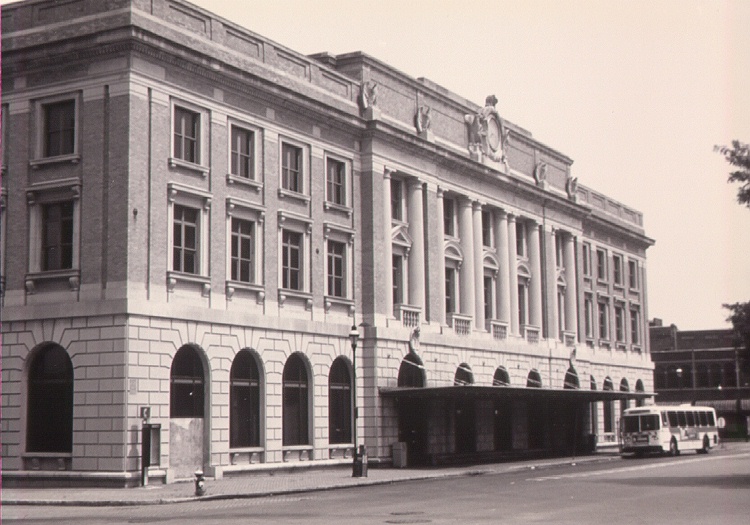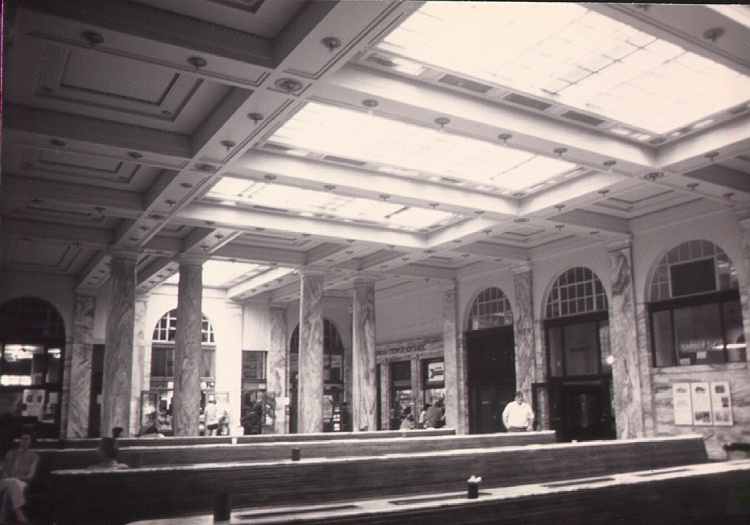Utica, New York
The New York Central station in Utica, NY is a unique building in
the tradition of the classical Beaux-Arts style. Opened in 1914
during the 'Golden Age of Railroading', Utica's station remains mostly
intact, and is still an active railroad station. Although much
diminished from its days when dozens of passenger trains called in the
city, it has few peers in today's world. Consider the fate of her
Central sisters: Albany, now a bank office building; Syracuse, formerly
a bus station (and not a very good one at that!) and now unused;
Rochester, photos and fading memories; Buffalo, rotting away in
abandonment. Utica lives!
Union Station occupies the north side of the 300 block of Main
St., near Baggs Square. This location is historic indeed, having
been used since the early part of the 19th century for
stagecoaches. Prior, the site was near a convenient fording
location on the Mohawk River. Just east of the station site was
located Fort Schuyler, of Revolutionary War fame. Later, toll roads
which eventually became NY Route 5 were built west from near the
site. In 1836 a station of Greek Revival design was built on Baggs
Square for the Syracuse and Utica Railroad. This was followed by a
new station in 1869. The 1914 structure was the culmination of a
series of public works improvements in the area. The Mohawk River
was relocated, (1901-1907) to alleviate flooding. A grade crossing
separation project was undertaken in 1908 to route Genesee Street over
the busy Central mainline and station platform tracks. Long a
junction point for passenger traffic to the Adirondack Mountains, Utica
also hosted branchline trains of the Delaware, Lackawanna & Western,
and the New York, Ontario & Western.

Plans for Utica's station were signed by architects Stem &
Fellheimer. (The same gentleman, Fellheimer, would later be involved in
Buffalo Central Terminal.) An often repeated story concerns the
marble columns used in the station's interior. Rumor had it that
these came from the second Grand Central Station in New York City which
was then being removed for the construction of Grand Central Terminal.
Contemporary descriptions of the Utica building do not mention the
source of the marble. The evidence suggests that the columns were
quarried in Vermont, especially for the station.

Perhaps the most pleasing aspect of the Utica station is its
interior. From the photo, one can see that Utica provides a glimpse of
what station elegance was all about during the railroad's well heeled
days. High coffered ceilings, marble columns, and skylights provide a
light filled waiting room. Unique oak benches surround heat
fixtures. Walls are furnished in marble, floors in terrazzo.
Flanking the waiting room were located the restaurant of Guillaume &
Company, railroad ticket offices, and sundry small newsstands and
shops. The upper floors housed mostly railroad offices. I
first visited Utica in March of 1977, arriving by train with a chapter
excursion on the new Turbo equipment. In 1977, the station was quite a
bit tattered, and looked in danger of being torn down for an "Amshack".
Happily, a restoration project has put much of the station to productive
use, and returned the wonderful waiting room to some of its former
glory. Trackside, one can still watch a parade of Amtrak passenger
trains and hustling Conrail freights. The spirit of the Water
Level Route lives, in Utica!